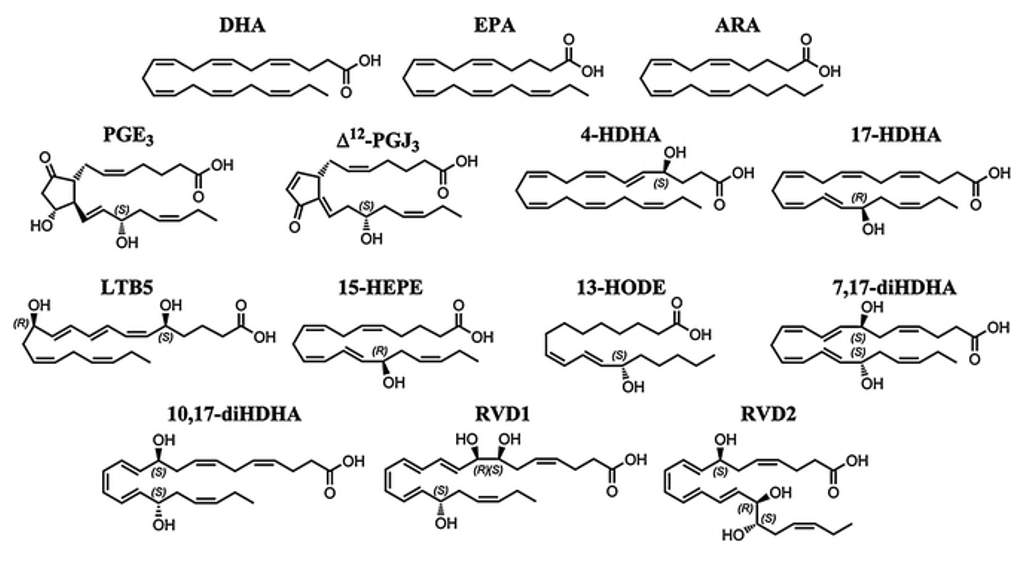biotech
Polyunsaturated fatty acids (PUFAs) are fatty acids that contain two or more unsaturated double bond structures. Depending on the position of the first unsaturated bond, PUFAs can be divided into ω-3, ω-6, ω-7, ω-9 series. ω-3 PUFAs mainly include α-linolenic acid (ALA), eicosapentaenoic acid (EPA), docosapentaenoic acid (DPA) and docosahexaenoic acid (DHA), etc. ω-6 PUFAs mainly include linoleic acid (LA), dihomo-γ-linolenic acid (DHGLA), γ-linolenic acid (GLA) and arachidonic acid (AA), etc. There are also ω-7 series and ω-9 series, such as eicosatrienoic acid, etc.

Functions of polyunsaturated fatty acids
- PUFAs and obesity
Studies have shown that there are disorders of fatty acid metabolism in the obese state, which may be an adaptive response to obesity. An increased proportion of dietary ω-6 PUFAs can cause fat aggregation in the body and promote obesity, while an increased proportion of ω-3 PUFAs has the effect of inhibiting fat aggregation. In obesity, adipose tissue will synthesize and release a large amount of inflammatory mediators such as tumor necrosis factor, interleukin and C-reactive protein, which are involved in physiopathological processes, and to a certain extent, it will promote the increased reactivity of ω-3 PUFAs to antagonize the inflammatory effects of these inflammatory factors.
Hypocretin-1 is secreted by hypothalamic secretory cells. The secretory effect of hypothalamic secretory cells can be inhibited by leptin and hyperglycemic state, and activated by ghrelin and hypoglycemic state, according to which hypocretin-1 has been found to enhance appetite, increase the amount of food eaten and accelerate catabolism. The main function of leptin is to regulate energy metabolism, and the expression and secretion of leptin are influenced by various factors such as diet, hormones, and disease. Elevated plasma leptin levels and leptin resistance are one of the main pathological features of obesity. ω-3 and ω-6 PUFAs may be associated with the development of leptin resistance, but the direct regulation of leptin expression by these two types of fatty acids cannot be determined.
PUFAs and cardiovascular diseases
Dietary fatty acids are associated with lipid metabolism, coronary heart disease (CHD), and atherosclerosis (AS). ω-6 PUFAs cause platelet agglutination and thrombosis, while ω-3 PUFAs have the opposite effect. Excess dietary ω-6 PUFAs increase blood viscosity, vasospasm and vasoconstriction, and increased ω-3 PUFAs in the diet alleviate these symptoms. However, excessive intake of ω-3 PUFAs also has the risk of aggravating bleeding. Excessive intake of EPA and DHA causes excessive inhibition of TXA2 formation, resulting in prolonged bleeding time, aggravation of bleeding phenomenon, and may even increase the risk of cerebral hemorrhage.
PUFAs and anti-inflammation
Supplementation with ω-3 PUFAs or fish oil can improve some immune diseases and suppress inflammatory responses. ω-3 PUFAs (EPA, DHA) can replace AA in cell membrane phospholipids and compete with cyclooxygenase and lipoxygenase to reduce various types of inflammatory mediators produced by AA and reduce inflammatory responses. ω-3 PUFAs can also change the fatty acid composition of cell membrane phospholipids to alter cell membrane fluidity, the function of membrane-related signaling molecules, enzymes, and receptors to alter the signaling process.
PUFAs and cell membrane function and organismal immunity
PUFAs are important components of cell membrane phospholipids, which are important determinants of cell membrane function and play an important role in cell surface signaling. ω-3 PUFAs inhibit cellular immunity by inhibiting antigen presentation by antigen-presenting cells. ω-6 PUFAs inhibit cell-mediated immune function. ω-3 PUFAs have the ability to alter the function of complement and immune cells. ω-6 PUFAs fat emulsions can also inhibit the function of natural killer cells (NK cells) in humans.
In addition, PUFAs also perform their physiological functions in a variety of diseases such as sudden death, depression, childhood attention deficit hyperactivity disorder, and Alzheimer's disease.
Polyunsaturated fatty acid detection methods
- Nuclear magnetic resonance (NMR): It can be used to detect the relative intracellular polyunsaturated fatty acid content in microorganisms such as microalgae, bacteria, fungi and yeast. It is performed by centrifuging the cell culture, resuspending the bacteria in buffer, and measuring the NMR H spectrum or °C spectrum. The intensity ratios of the characteristic peaks on the NMR spectra are used to compare the contents of polyunsaturated fatty acids in different samples.
- Gas chromatography (GC): A standard curve is established using an external standard, and then the polyunsaturated fatty acid content can be determined by GC.
- High-performance liquid chromatography: Samples are separated using high-performance liquid chromatography and identified by evaporative light scattering detector (ELSD) or DAD detector to achieve efficient and accurate determination of unsaturated fatty acids.
